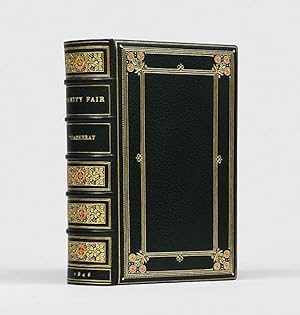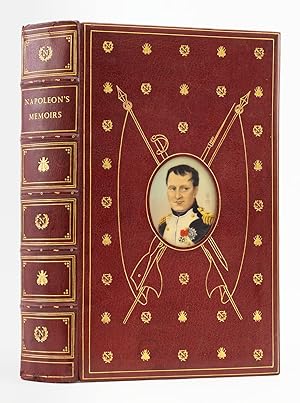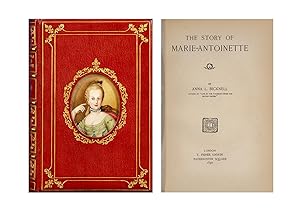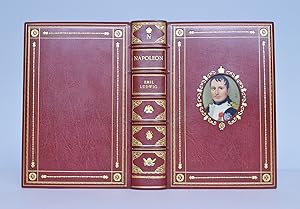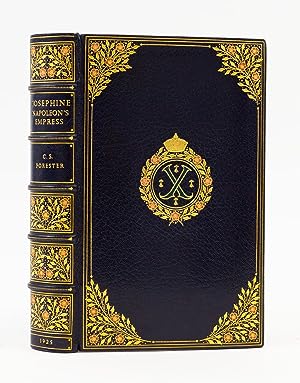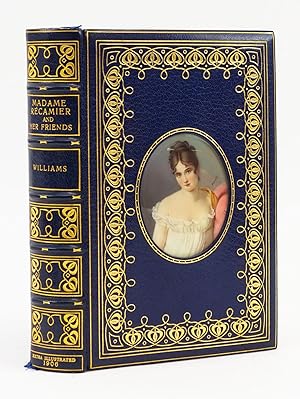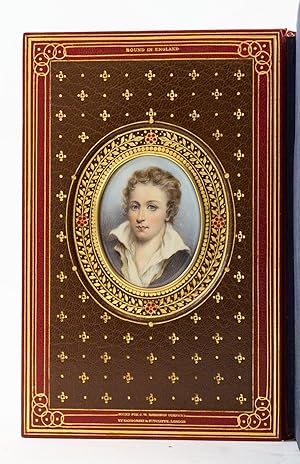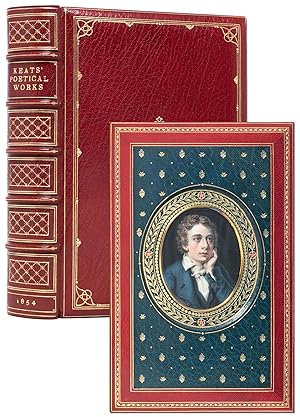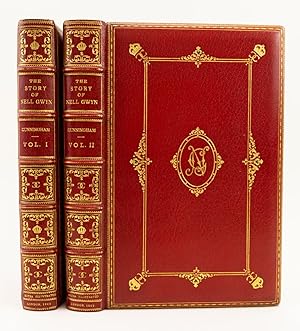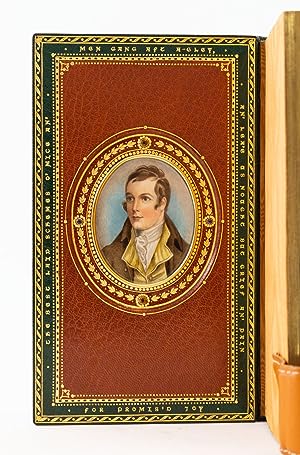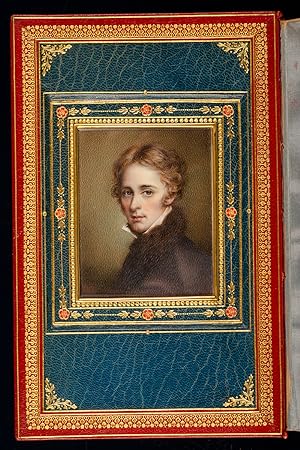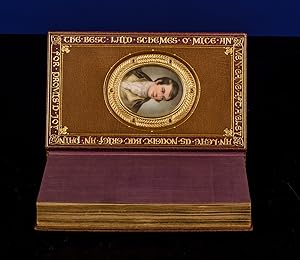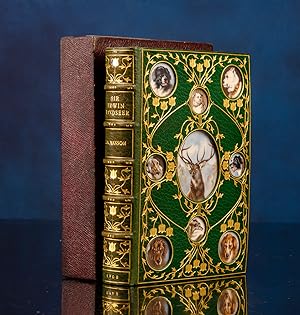Sangorski Sutcliffe Cosway (25 results)
FeedbackSearch filters
Product Type
- All Product Types
- Books (25)
- Magazines & Periodicals (No further results match this refinement)
- Comics (No further results match this refinement)
- Sheet Music (No further results match this refinement)
- Art, Prints & Posters (No further results match this refinement)
- Photographs (No further results match this refinement)
- Maps (No further results match this refinement)
- Manuscripts & Paper Collectibles (No further results match this refinement)
Condition
- All Conditions
- New (No further results match this refinement)
- Used (25)
Binding
- All Bindings
- Hardcover (4)
- Softcover (No further results match this refinement)
Collectible Attributes
- First Edition (13)
- Signed (1)
- Dust Jacket (No further results match this refinement)
- Seller-Supplied Images (23)
- Not Print on Demand (25)
Free Shipping
Seller Rating
-
Vanity Fair. A Novel Without a Hero. With Illustrations on Steel and Wood by the Author.
Published by London: Bradbury and Evans, 1848, 1848
Seller: Peter Harrington. ABA/ ILAB., London, United Kingdom
First Edition
First edition in book form, in a splendid Cosway-style binding with an oval miniature portrait of Thackeray set into the front doublure, after Samuel Lawrence. Cosway bindings, in which beautiful miniature paintings are inset into fine leather bindings, originated in the first decade of the 20th century at the instigation of J. H. Stonehouse, managing director of Sotheran's. The style was soon imitated by Bayntun-Rivière, Sangorski & Sutcliffe, and other English craft binders, and examples have long been sought after by collectors. The novel, published in serial form from 1847 to 1848 and afterwards in book form, proved a genuine popular success, and the sheets were reprinted multiple times. This copy has the first state title page, the other traditional points generally indicating corrected printings. "Modern editions of this classic novel almost invariably omit Thackeray's vignettes and often give only a selection from his etchings. The reader is deprived thereby not only of much amusement but also of important clues to the meaning of the story" (Ray, p. 75). Ray, The Illustrator and the Book in England from 1790 to 1914, 122; Wolff 6699. Octavo (218 x 132 mm). Mid 20th-century green morocco for Charles J. Sawyer, spine with raised bands, floral gilt decoration with red morocco Lancashire rose onlays in compartments and to covers, board edges ruled in gilt, red morocco doublures with elaborate gilt borders and light blue morocco onlays, front doublure in Cosway-style with central oval miniature portrait of Thackeray, under glass and framed in brass, watered silk endpapers, edges gilt. Housed in a custom green cloth solander box. Etched frontispiece, vignette title page, and 38 plates, wood-engraved vignettes and initials in the text, all after Thackeray. With Charles J. Sawyer's advertisement loosely inserted. A near-fine copy, elaborately bound, faint foxing and occasional offsetting to contents, otherwise clean.
-
NAPOLEON'S MEMOIRS
Published by Golden Cockerel Press, Waltham St. Lawrence, 1945
Seller: Phillip J. Pirages Rare Books (ABAA), McMinnville, OR, U.S.A.
Signed
No. 412 OF 500 NUMBERED COPIES. 317 x 190 mm. (12 1/2 x 7 1/2"). 422, [2]; 78, [2] pp. Two volumes bound in one. Translated and edited by Somerset de Chair. HANDSOME RED MOROCCO BY BAYNTUN (RIVIERE) (stamp-signed in gilt on rear turn-in), covers with double gilt rule surrounding a field of alternating gilt tools (a bee, and the letter "N" encircled by a wreath), upper board with inset WATERCOLOR OVAL PORTRAIT OF NAPOLEON, with two flags, a gun, and a saber outlined in gilt appearing to cross behind it, lower cover with large gilt armorial device, raised bands, compartments ruled in gilt with bee or "N" tool at the center, gilt lettering, thick turn-ins with gilt rules and decorative cornerpieces, blue watered silk endleaves, top edge gilt, others untrimmed, original map endpapers bound in. Volume I with a frontispiece portrait of Napoleon, volume II with a black and white photograph of a modern sculpture of the general, title page of each volume with a woodcut design of an eagle clutching a flag among other accoutrements of war. Title page of volume one SIGNED BY THE EDITOR in ink. Chanticleer 167; Cave & Manson 167. âSmall nick to head of spine and some minor damage along the tail, two small stains and a couple of dings to covers, but still a beautiful binding in very pleasing condition. Small repair to edge of one of the map endpapers, one or two isolated trivial smudges elsewhere, but the contents nearly pristine. This is a finely bound copy of an innovative version of the memoirs that were based on conversations between Napoleon and Emmanuel-Augustin-Dieudonné-Joseph, Comte de Las Cases (1766-1842). The count accompanied the defeated emperor into exile on Saint Helena as an informal secretary, took a great many notes about Napoleon's life, inserted his own impressions, colored his account to the point of (favorable) misrepresentation, and published the work as the celebrated "Mémorial de Ste. Hélène," from which he made a substantial amount of money. Our translator and editor Somerset de Chair has turned the text into a first-person narrative and rearranged the pieces so that events are recalled in chronological order. The first volume covers the general's career from Corsica to Marengo, and the second is devoted to Waterloo. The so-called "Cosway" binding, featuring handsome morocco inset with one or more painted miniatures, apparently originated with the London bookselling firm of Henry Sotheran about 1909. It was in that year that G. C. Williamson's book entitled "Richard Cosway" (dealing with the British miniature painter of that name, 1742-1821) was remaindered by Sotheran and presumably given this special decorative treatment. The name "Cosway" was then used to describe any book so treated, whoever its author. Other prominent binderies, chiefly Sangorski & Sutcliffe and Bayntun, produced their own versions of the popular style. The Bayntun firm, founded in Bath in 1894, is now the last of the great Victorian trade binderies still in family ownership. Among the great English workshops of the Edwardian "golden age" of lavish bindings, Bayntun has the distinction of being the only one located outside London's West End to be sought after by bibliophiles. In 1939, Bayntun took over the esteemed Riviere firm, founded in 1829. The oval portrait on the present work is especially pleasing because it communicates something of Napoleon's character: he appears smug and in control, yet expressing some of the famous charisma that contributed to his success. The miniature bears the monogram "WMB," quite likely the initials of William Mineard Bennet (1778-1858), a painter and miniaturist who studied under Thomas Lawrence. According to Benezit, he went to Paris in 1835 "where he was extremely well received, enjoying the patronage of both the Duke de Berry and King Louis-Philippe.".
-
The Story of Marie-Antoinette
Published by T. Fisher Unwin, London, 1897
Seller: Whitmore Rare Books, Inc. -- ABAA, ILAB, Pasadena, CA, U.S.A.
First Edition
Condition: Fine. First edition. Octavo (8 3/8 x 5 3/4 inches; 212 x 146 mm.). [i]-xiv, [2], 334, [2, blank] pp, twenty-seven photogravure plates. Bound ca 1960 in full red crushed levant morocco, covers decoratively bordered in gilt, front cover with a central gilt design surrounding a fine oval hand-painted portrait miniature of Marie-Antoinette (3 1/4 x 2 1/2 inches; 82 x 63 mm.), set under glass. Spine with five raised bands elaborately tooled and lettered in gilt in compartments. Double-ruled gilt board edges and wide turn-ins, red silk liners and endleaves, all edges gilt. A Fine copy overall. Housed in the original fleece-lined, red cloth clamshell case, spine lettered in gilt. The binding is unsigned but is very similar to the Cosway-Style bindings that were done by Sangorski & Sutcliffe for Asprey's. Marie-Antoinette (1755-1793) was the infamous last queen of France before the French Revolution. The youngest daughter of Empress Maria Theresa and Emperor Francis I, the archduchess of Austria became dauphine of France in May 1770 at age 14 upon her marriage to the Dauphin Louis-Auguste (the future King Louis XVI). Celebrated and criticized for her extravagant fashion (among many other things), her life continues to fascinate. Anna Louise Bicknell (1835?-), was an author and historian who published extensively on French history. In addition to her biography on Marie-Antoinette, she published the book Life in the Tuleries under the Second Empire (1894) and wrote several Century Magazine and National Geographic including: The Pretenders to the Throne of France (1883); Marie-Antoinette as Dauphine (1897), The Last Days of Louis XVI and Marie-Antoinette (1897); French Wives and Mothers (1898). The story of the Sangorski & Sutcliffe Bindery reads like something out of a novelâ"when two of Douglas Cockrell's talented apprentices, Frances Sangorski and George Sutcliffe, were laid off during an economic downturn they began working out of an attic. Eventually their bindery would be famous for its intricate multicolored leather inlays and elaborate gold and jeweled bindings. Although named after the English miniaturist Richard Cosway (1742-1821), the desirable "Cosway Binding" with its jewel-like portrait miniature set into a fine binding was first developed at the turn of the century by J.H. Stonehouse, director of London's Henry Sotheran Booksellers. Their miniatures were painstakingly crafted by the talented painter Miss C. B. Currie (1849-1940). As the style grew in popularity, other publishing houses quickly began to reproduce this techniqueâ"each developing their own desirable take on the aestheticâ"referred to as "Cosway style.". Fine.
-
Napoleon
Published by Boni & Liveright, New York, 1926
Seller: George Bayntun ABA ILAB PBFA, Bath, United Kingdom
First Edition
Hardcover. Condition: Very Good. First Edition. Translated by Eden and Cedar Paul. 21 plates. First Edition. 8vo. [235 x 155 x 52 mm]. xii, [ii], 707 pp. Bound c.2000 by Sangorski & Sutcliffe for Asprey in "Cosway-style" of red goatskin, the covers tooled in gilt with a triple fillet border with chain rolls, bees and "N" within a laurel wreath, at the centre of the front cover an inlaid miniature portrait of Napoleon painted on ivorene framed with gilt emblematic tools. The spine divided into six panels with raised bands and gilt compartments, lettered in the second and third, the others with emblematic centres and volutes in the corners, the edges of the boards and turn-ins tooled with gilt fillets, Cockerell marbled endleaves, gilt edges. Contained in a quarter red goatskin drop-over box with red cloth sides, the spine with raised bands and tooled in gilt to reproduce the book. New York: Boni & Liveright.
-
The Poetical Works of Oliver Goldsmith
Published by William Pickering, London, 1831
Seller: Whitmore Rare Books, Inc. -- ABAA, ILAB, Pasadena, CA, U.S.A.
Condition: Near Fine. The Aldine Edition. Small octavo (6 1/2 x 4 inches; 166 x 101 mm.). [i]-clxxxii [Life and Anecdotes of Goldsmith], [1]-156 pp, with engraved portrait frontispiece. Bound c. 1930 by Sangorski and Sutcliffe for Chas. J. Sawyer Ltd., stamp-signed in gilt on front turn-in, with the S&S monogram stamped in gilt on rear doublure. Full dark red crushed levant morocco over beveled boards with elaborate gilt-rolled borders and gilt-tooled frame. Front cover with Oliver Goldsmith's initials within a decorative thistle tool frame. Rear cover with central gilt wreath. Spine with five raised bands elaborately decorated and lettered in gilt in compartments. Gilt-ruled board edges, broad, gilt-rolled dentelles, green silk end-leaves, top edge gilt. Gilt-tooled green calf doublures with decorative gilt corner-pieces. Front doublure with a fine gilt-framed oval portrait miniature watercolor under glass of Oliver Goldsmith. Front joint expertly and almost invisibly repaired. A Near Fine example of an S&S Cosway-Style binding. The Anglo-Irish author Oliver Goldsmith (1730-1774), is probably best known for his popular novel Vicar of Wakefield (1766). Here however readers encounter a different side to his craft. Part of The Aldine Poet Seriesâ"a twenty-year long and fifty-three volume project of new editions of classic British poets from Chaucer through to the nineteenth centuryâ"this book highlights Goldsmith's poetry. Apart from poetry and novels, Goldsmith wrote plays and legend has it, the children's story The History of Little Goody Two-Shoes. Kept busy by writing quickly and voluminously for Grub Street, the center of London's disreputable part of the literary world, Goldsmith nevertheless also found time to hone novels such as The Vicar of Wakefield, poems such as The Deserted Village, and plays such as She Stoops to Conquer. Contemporaries celebrated Goldsmith's ability to craft deceptively complex characters, most notably in the case of Charles Primrose, the vicar from The Vicar of Wakefield. Goldsmith counted Samuel Johnson among his closest friends, and Johnson wrote the epitaph that appears on Goldsmith's memorial in Westminster Abbey's famous Poets' Corner: "To the memory of Oliver Goldsmith, poet, philosopher and historian, by whom scarcely any style of writing was left untouched and no one touched unadorned, whether to move to laughter or tears; a powerful, yet lenient master of the affections, in genius sublime, vivid, and versatile, in expression, noble, brilliant, and delicate, is cherished in this monument by the love of his companions, the fidelity of his friends, and the admiration of his readers." The story of the Sangorski & Sutcliffe Bindery reads like something out of a novelâ"when two of Douglas Cockrell's talented apprentices, Frances Sangorski and George Sutcliffe, were laid off during an economic downturn they began working out of an attic. Eventually their bindery would be famous for its intricate multicolored leather inlays and elaborate gold and jeweled bindings. Although named after the English miniaturist Richard Cosway (1742-1821), the desirable "Cosway Binding" with its jewel-like portrait miniature set into a fine binding was first developed at the turn of the century by J.H. Stonehouse, director of London's Henry Sotheran Booksellers. Their miniatures were painstakingly crafted by the talented painter Miss C. B. Currie (1849-1940). As the style grew in popularity, other publishing houses quickly began to reproduce this techniqueâ"each developing their own desirable take on the aestheticâ"referred to as "Cosway style.". Near Fine.
-
A History of India from the Earliest Times to the Present Day
Published by Ivor Nicholson & Watson Limited, London, 1936
Seller: Whitmore Rare Books, Inc. -- ABAA, ILAB, Pasadena, CA, U.S.A.
First Edition
Condition: Near Fine. First edition. Octavo (7 15/16 x 5 3/8 inches; 202 x 137 mm.). [xxiv], 1-[632] pp. Erratum slip inserted facing p. [viii]. Thirty-four photogravure plates containing sixty-four illustrations. Sixteen colored maps including one large folding at end. Bound ca. 1936 by Sangorski & Sutcliffe, stamp signed in gilt on front turn-in. Full red crushed levant morocco over beveled boards, covers richly decorated on gilt, spine with five raised bands decoratively tooled and lettered in gilt in compartments, decorative gilt board edges, elaborate gilt turn-ins, gilt decorated blue morocco doublures, ochre watered silk endleaves, all edges gilt. With the gilt initials of Ohio collector B. C. Hoffman at foot of the spine. Inside front cover with large oval sunken panel with a fine gold-framed oval miniature under glass of a Maharaja (2 x 1 1/2 inches), and on the inside rear cover a fine gold-framed oval miniature under glass of a Raja (2 x 1 1/2 inches). Expert and almost invisible repair to foot of spine. Minimal rubbing to joints, otherwise near fine. An excellent example of a 'double' Sangorski & Sutcliffe Cosway-Style binding. "A history of India is equivalent in range to the history of Europe George Duff-Sutherland-Dunbar (1878-1962) declares in his preface, admitting "it is clearly impossible to compress the history of India into a single volume and deal adequately with every period." That said, he makes a progressive move to "compile a History of India from the standpoint of the governed rather than the many rulers of the country." A colonial officer and historian, Dunbar had firsthand experience in India as a member of the British forces, and a deep interest in the nation's evolving culture. Across over 600 pages, his tome traces the earliest periods on the country's political and religious development, documenting how people experienced cultural shifts due to frequently jarring and violent changes in leadership across centuries; and he includes, at the end, an account of British imperialism. The story of the Sangorski & Sutcliffe Bindery reads like something out of a novelâ"when two of Douglas Cockrell's talented apprentices, Frances Sangorski and George Sutcliffe, were laid off during an economic downturn they began working out of an attic. Eventually their bindery would be famous for its intricate multicolored leather inlays and elaborate gold and jeweled bindings. Although named after the English miniaturist Richard Cosway (1742-1821), the desirable "Cosway Binding" with its jewel-like portrait miniature set into a fine binding was first developed at the turn of the century by J.H. Stonehouse, director of London's Henry Sotheran Booksellers. Their miniatures were painstakingly crafted by the talented painter Miss C. B. Currie (1849-1940). As the style grew in popularity, other publishing houses quickly began to reproduce this techniqueâ"each developing their own desirable take on the aestheticâ"referred to as "Cosway style.". Near Fine.
-
JOSEPHINE, NAPOLEON'S EMPRESS
Published by Metheun & Co, London, 1925
Seller: Phillip J. Pirages Rare Books (ABAA), McMinnville, OR, U.S.A.
First Edition
FIRST EDITION. 216 x 140 mm. (8 1/2 x 5 1/2"). vii, [i], 246 pp. SUPERB CONTEMPORARY DEEP BLUE MOROCCO BY SANGORSKI & SUTCLIFFE FOR ASPREY, WITH MORE THAN 60 INLAYS, front cover with center medallion featuring inlaid teal blue crossed "J's," surrounded by gilt wreath and crown as well as inlaid pink flowers, lovely gilt floral sprays with more inlaid pink flowers in corners of both covers, raised bands, spine beautifully gilt and inlaid in the same floral vine pattern, DOUBLURES OF CRIMSON MOROCCO with inlaid blue flowers in corners, as well as an intricate series of patterned rules against deep blue morocco border, FRONT DOUBLURE WITH FINE INSET HAND-PAINTED IVORY MINIATURE OF JOSEPHINE, watered silk free end papers, gilt edges. In a slightly scuffed but sturdy and attractive morocco-backed plush-lined folding cloth box, gilt titling on spine. With 12 illustrations (all photographs of portraits), as called for. âA CHOICE BINDING IN IMMACULATE CONDITION. Our sumptuous binding would no doubt have pleased the subject of this work, known for her exquisite taste and love of beautiful things. When she met and captivated Napoleon Bonaparte in 1795, Josephine de Beauharnais (1763-1814) was a Martinique-born widow of an aristocrat who had died in the Reign of Terror. Josephine married the general in January of 1796, despite the fact that she was (a shocking) six years his senior. In this biography, the British writer C. S. Forester (1899-1966), best known for his beloved Horatio Hornblower series, portrays the empress with great sympathy. Sanford V. Sternlicht notes that in telling the dramatic story of her rise to the imperial throne and her fall when she was unable to produce an heir for the emperor, "Forester almost treats Josephine as a fictional character as he finely draws a portrait of a poorly educated but clever woman who . . . rolls with the punches of fate and outlives her foes." The so-called "Cosway" binding, featuring handsome morocco inset with one or more painted miniatures, apparently originated with the London bookselling firm of Henry Sotheran about 1909. It was in that year that G. C. Williamson's book entitled "Richard Cosway" (dealing with the British miniature painter of that name, 1742-1821) was remaindered by Sotheran and presumably given this special decorative treatment. The name "Cosway" was then used to describe any book so treated, whoever its author. Although the artist of our miniature is unidentified, the work here is remarkably well done, with carefully painted detail showing the empress at the prime of her life, bedecked with emeralds, pearls, and rubies, but with a sadness in her large brown eyes that foreshadows the heartbreak to come.
-
Essays of Elia and Last Essays of Elia
Published by William Paterson, Edinburgh, 1885
Seller: James Cummins Bookseller, ABAA, New York, NY, U.S.A.
Extra-illustrated. 2 vols. 4to. Extra-illustrated. 2 vols. 4to. The miniature portraits are of Charles Lamb in Volume One, and of Mary Lamb in Volume Two (Last Essays). Blue morocco, gilt, with Cosway style miniature on the front pastedown of each volume, "designed and bound by Sangorski & Sutcliffe, London".
-
An Outcast of the Islands
Published by T. Fisher Unwin, London, 1896
Seller: Whitmore Rare Books, Inc. -- ABAA, ILAB, Pasadena, CA, U.S.A.
First Edition
Condition: Fine. First edition. Octavo (7 3/4 x 4 7/8 inches; 197 x 124 mm.). [ii, ads], [vi], 391, [1] pp. First issue, with "this" for "their" on p. 26, line 31; "Absolution" for "ablution" p. 110, line 12; "9" missing on p. 129; and "hate" for "fate" on p. 356, line 26. Title-page in red and black. Bound ca, 1940 by Sangorski & Sutcliffe, stamp-signed in gilt on rear turn-in. A Fine copy, bound in full dark blue crushed levant morocco over beveled boards, covers elaborately bordered in gilt with decorative anchor corner-pieces, front cover with a sailing ship in gilt. Spine with five raised bands, decoratively tooled and lettered in gilt in compartments, gilt-ruled board-edges and turn-ins, blue watered silk endleaves. Inside front cover with a large rectangular panel of green morocco with a superb and exquisite oval portrait miniature of Joseph Conrad (3 x 2 3/8 inches) under glass and surrounded by a gilt metal frame. Original green cloth covers and spine bound in at end. Housed in the original fleece-lined blue cloth clamshell case, spine lettered in gilt. Front hinge of clamshell case neatly repaired, rear hinge starting. Joseph Conrad (1857-1924) was a Polish-British writer whose reputation as one of the greatest English-language novelists holds true today. Conrad's prose is infused with a unique sensibility blurring the boundaries between modernism and realism; he was never afraid to depict the darkness of the humanity. In much of his fiction Conrad drew from his experiences as a sailor, such as in his second novel An Outcast of the Islands (1896), which recounts the downfall of Peter Willems. As in his more famous Heart of Darkness, Conrad relishes in this jungle setting. The story of the Sangorski & Sutcliffe Bindery reads like something out of a novelâ"when two of Douglas Cockrell's talented apprentices, Frances Sangorski and George Sutcliffe, were laid off during an economic downturn they began working out of an attic. Eventually their bindery would be famous for its intricate multicolored leather inlays and elaborate gold and jeweled bindings. Although named after the English miniaturist Richard Cosway (1742-1821), the desirable "Cosway Binding" with its jewel-like portrait miniature set into a fine binding was first developed at the turn of the century by J.H. Stonehouse, director of London's Henry Sotheran Booksellers. Their miniatures were painstakingly crafted by the talented painter Miss C. B. Currie (1849-1940). As the style grew in popularity, other publishing houses quickly began to reproduce this techniqueâ"each developing their own desirable take on the aestheticâ"referred to as "Cosway style.". Fine.
-
MADAME RÉCAMIER AND HER FRIENDS
Published by Harper & Brothers, London and New York, 1906
Seller: Phillip J. Pirages Rare Books (ABAA), McMinnville, OR, U.S.A.
New and Revised Edition. 212 x 138 mm. (8 1/2 x 5 1/2"). xi, [1], 349, [1] pp. VERY PRETTY DARK BLUE CRUSHED MOROCCO, GILT, BY BAYNTUN (stamp-signed on front turn-in), covers with elegant Art Nouveau-style gilt frame, UPPER COVER WITH INSET 19TH CENTURY OVAL MINIATURE PORTRAIT of Madame Récamier (signed "Renoir" in the background) under glass, raised bands, spine compartments with gilt frames matching those on covers, gilt lettering, taupe watered silk endleaves, all edges gilt. In a blue buckram clamshell box. With color frontispiece portrait, as called for, and EXTRA-ILLUSTRATED WITH 16 PLATES, six of these in color, all with tissue guards. âIsolated faint spots of foxing, but a splendid copy, clean, fresh, and bright internally, in a binding that looks like new. This account of the great French beauty and the distinguished literary and political figures who populated her lively salon is elegantly bound in the Cosway style, with a beautifully rendered miniature based on the most famous portrait of Récamier gracing its front cover. The "Cosway" binding, with painted miniatures inlaid in handsome morocco, apparently originated with the London bookselling firm of Henry Sotheran about 1909, the year G. C. Williamson's book entitled "Richard Cosway" was remaindered by Sotheran and presumably given this special decorative treatment in order to promote sales. The name "Cosway"--referring to the British miniature painter, Richard Cosway (1742-1821)--was then used to describe any book so treated, whatever its subject. Miniatures for the earliest Cosway bindings were executed by Miss C. B. Currie, who is known to have worked between 1912-40, usually from designs by J. H. Stonehouse that were executed by the Riviere workshop. Other prominent binderies, chiefly Sangorski & Sutcliffe and Bayntun, began to produce their own versions of the popular style. The Bayntun firm was founded in Bath in 1894 and is now the last of the great Victorian trade binderies still in family ownership. Among the great English workshops of the Edwardian "golden age" of lavish bindings, Bayntun has the distinction of being the only one located outside London's West End to be sought after by bibliophiles. In 1939, Bayntun took over the esteemed Riviere firm, founded in 1829. The portrait here is, unusually, signed. "Renoir" is not the great Impressionist, but a talented 19th century miniaturist who specialized in portraits of figures from the Napoleonic era, some produced in partnership with an artist named Dupré. Jeanne Françoise Julie Adélaïde Récamier (1777-1849), known as Juliette, was not only beautiful, but also intelligent, charming, and a gifted hostess whose salon drew luminaries from the arts, literature, and politics. Among her close friends were the famed salonnière Germaine de Staël, the writer François-René de Chateaubriand, and the political activist Benjamin Constant. Portraits of her associates have been added to this work.
-
India. A Birds-Eye View by the Earl of Ronaldshay
Published by Constable and Company Limited, London, 1931
Seller: Whitmore Rare Books, Inc. -- ABAA, ILAB, Pasadena, CA, U.S.A.
Condition: Fine. Later printing. (First published in 1924). Octavo (8 3/16 x 5 inches; 208 x 127 mm.). [ii], xiii, [xiv, blank], 322 pp. Twenty-four photographic plates and large folding map at end. Beautifully bound ca. 1931 by Sangorski & Sutcliffe, stamp-signed in gilt on front turn-in. Full brown crushed levant morocco, covers elaborately paneled in gilt, decoratively gilt-ruled board edges, elaborate gilt turn-ins. Spine with five raised bands, decoratively tooled and lettered in gilt in compartments. Purple morocco liners decoratively stamped with gilt stars, ochre watered silk end papers. Inside front cover with large rectangular sunken panel with three very fine gold-framed oval miniatures under glass of Shah Jahan (2 x 1 1/2 inches), Mumtaz Mahal (2 x 1 1/2 inches) and a painting of the Taj Mahal (1 x 1 3/8 inches). A very fine example of a Sangorski & Sutcliffe Cosway-Style binding. From the library of Ohio book collector B. C. Hoffman, with his initials in gilt at foot of spine. Housed in the original fleece-lined, brown morocco-edged, tan cloth clip case. Lawrence John Lumley Dundas, 2nd Marquess of Zetland (1876-1961), also called the Earl of Ronaldshay, was a British Conservative politician, who served British colonial interests in India for more than twenty years, notably as Governor of Bengal and Secretary of State for India. Lord Ronaldshay's India, A Birds-Eye View was written for British citizens who "want more than a mere narrative of travel" but "something less than the studies of specialists." designed as a series of "historical, pictorial, statistical, and ethnographical vignettes" interspersed with photographic plates of Indian geography and architecture taken by the author himself. Ronaldshay's goal was to "construct a mosaic which will present to the man who wishes to know something of this huge and varied land, whose recent history has been bound up so intimately with his own, an intelligible conspectus" (Preface). The story of the Sangorski & Sutcliffe Bindery reads like something out of a novelâ"when two of Douglas Cockrell's talented apprentices, Frances Sangorski and George Sutcliffe, were laid off during an economic downturn they began working out of an attic. Eventually their bindery would be famous for its intricate multicolored leather inlays and elaborate gold and jeweled bindings. Although named after the English miniaturist Richard Cosway (1742-1821), the desirable "Cosway Binding" with its jewel-like portrait miniature set into a fine binding was first developed at the turn of the century by J.H. Stonehouse, director of London's Henry Sotheran Booksellers. Their miniatures were painstakingly crafted by the talented painter Miss C. B. Currie (1849-1940). As the style grew in popularity, other publishing houses quickly began to reproduce this techniqueâ"each developing their own desirable take on the aestheticâ"referred to as "Cosway style.". Fine.
-
Vanity Fair
Published by Bradbury & Evans, London, 1848
Seller: Whitmore Rare Books, Inc. -- ABAA, ILAB, Pasadena, CA, U.S.A.
First Edition
Condition: Fine. First edition. First issue with the suppressed woodcut of the Marquis of Steyne on page 336, with "Mr. Pitt" for "Sir Pitt" on page 453, and the rustic heading on page one. Octavo (8 5/16 x 5 1/8 inches; 210 x 130 mm.). xvi, 624 pp, with thirty-eight black and white steel engraved plates with tissue guards and one hundred and fifty woodcuts in the text by Thackeray. Expert paper repair to pages [xv] and xvi. Plates generally a little toned, still a near fine and very desirable copy of this classic. Bound c. 1920 by [Sangorski & Sutcliffe] stamped signed "Bound for Harry F. Marks. London" on lower turn-in. Full crimson crushed levant morocco over beveled boards, covers elaborately bordered in gilt, decorative gilt corner-pieces, each with a gilt triple flower design inlaid with green morocco petals. Spine with five raised bands, elaborately tooled in a similar floral design with four large flowers with tan morocco inlays, lettered in gilt in compartments. Inside front cover with large rectangular dark blue morocco inlaid panel, decorative gilt corner-pieces surrounding an oval gilt frame with a very fine hand-painted portrait miniature set under glass of the young Thackeray - possibly by Miss C.B. Currie. Double gilt-ruled board edges, highly decorative gilt turn-ins, blue watered silk endleaves (with a small chip at the fore-edge of the front leaf), all edges gilt. Minimal rubbing to joints (front joint touched up) otherwise near fine. Housed in a felt-lined red cloth clamshell case, spine with leather label, lettered in gilt. Considered by its author to be a novel without a hero, Vanity Fair follows the path of the social climbing Becky Sharp as she seeks to improve her position within the British social strata set around the time the Napoleonic Wars. One of literature's most important early iterations of the female anti-hero, Miss Sharp helped to expose the truth that women were not merely domesticated angels but could be just as ambitious and driven as their male counterparts; and her foil Amelia reveals that even an apparent paragon of femininity was imperfect. A contemporary Victorian reviewer noted "Thakeray's theory of characterization proceeds generally on the assumption that the acts of men and women are directed not by principle but by instincts.There is not a person in the book who excites the reader's respect, and not one who fails to exited his interest. The morbid quickness of the author's perceptions of the selfish element, even in his few amiable characters, is a constant source of surprise. The novel not only has no hero, but implies the non-existence of heroism" (Contemporary Atlantic Monthly review). It was first published as in 19-part monthly serial from 1847 to 1848 with illustrations by Thackeray, and in 1848 published in book form with the subtitle "A Novel Without a Hero." A literary tour de force, transformed into a popular film starring Reese Witherspoon. Harry F. Marks, was a renowned early twentieth century New York City bookman and the Black Sun Press' distributor in America. Marks had many books specially bound for his clientele by Sangorski & Sutcliffe. The story of the Sangorski & Sutcliffe Bindery reads like something out of a novelâ"when two of Douglas Cockrell's talented apprentices, Frances Sangorski and George Sutcliffe, were laid off during an economic downturn they began working out of an attic. Eventually their bindery would be famous for its intricate multicolored leather inlays and elaborate gold and jeweled bindings. Although named after the English miniaturist Richard Cosway (1742-1821), the desirable "Cosway Binding" with its jewel-like portrait miniature set into a fine binding was first developed at the turn of the century by J.H. Stonehouse, director of London's Henry Sotheran Booksellers. Their miniatures were painstakingly crafted by the talented painter Miss C. B. Currie (1849-1940). As the style grew in popularity, other publishing houses quickly began to reproduce this techniqueâ"each developing their own desirable take on the aestheticâ"referred to as "Cosway style." Grolier, 100 English, 87. Van Duzer 231. Wolff 6699. Fine.
-
The Posthumous Papers of the Pickwick Club. With forty-three illustrations by R. Seymour and Phiz.
Published by London: Chapman and Hall, 1837, 1837
Seller: Peter Harrington. ABA/ ILAB., London, United Kingdom
First Edition
First edition, in an extremely attractive Cosway-style binding featuring an oval miniature portrait of Dickens aged 27 after the painting by Daniel Maclise. All plates are present and in their early states with page numbers as called for, but with no titles or imprints. Two plates by R. W. Buss were suppressed and the replacement illustrations by H. K. Browne ("Phiz") are present in this copy. The Pickwick Papers, Charles Dickens's first novel, transformed the obscure journalist into England's most famous writer within months. The first monthly instalment was issued in an edition of 1,000 copies in April 1836. The work became a publishing sensation after the introduction of Sam Weller in chapter 10, the fourth instalment, issued in July 1836, after which the publishers reprinted the earlier instalments so that readers could catch up. By the time the book publication was issued in November 1837, many textual corrections had been made. Booksellers often list numerous (and confusing) text points that might conceivably apply to a perfect set of Pickwick Papers as originally issued in parts, but all these points could never be found together in the issues in book form. The serial was originally intended to be primarily a vehicle for the cartoons of Robert Seymour, until he died by suicide after the first number was published. Robert William Buss then took over, but he was inexperienced in steel engraving and had to be replaced. The final choice, Hablot Knight Browne ("Phiz"), was to be Dickens's chosen collaborator for the next two decades. Smith I.3. Octavo (210 x 122 mm). Early 20th-century green full morocco by Sangorski & Sutcliffe for Charles J. Sawyer, spine elaborately gilt in six compartments, covers with gilt borders, front cover with circular red morocco onlay with Dickens's monogram in gilt, gauffered edges gilt, red morocco doublures with elaborate gilt dentelles, front doublure in Cosway-style with central oval miniature portrait of Dickens after Maclise, under glass and framed in brass, watered silk endpapers, gilt-stamped facsimile of Dickens's signature to front free endpaper. Housed in a custom green cloth folding box. Etched vignette title page, frontispiece, 41 plates by Robert Seymour and H. K. Browne. A remarkably clean and fine example with some light foxing to frontispiece and etched vignette title page, as usual, some cockling to paper lining of free endpapers, and bound without half-title.
-
[Cosway Style Binding] Poems, Chiefly in the Scottish Dialect
Published by Printed for the Author; Sold by William Creech, Edinburgh, 1787
Seller: White Fox Rare Books, ABAA/ILAB, New York, NY, U.S.A.
Condition: Fine. Beautiful Sangorski & Sutcliffe Cosway style binding, with oval portrait of a young Burns, painted on ivory, serving as a centerpiece of inside front cover. Portrait surrounded by border of gilt leaf repeats, and six jeweled pieces. Boards decorated with 8vo. 21.5 by 13.5 cm. xlviii, 9-368 pp. Expertly rebacked, with virtually no conspicuous evidence of work having been done, and original spine and boards are fully preserved and in fine condition. Full Decorated Morocco. Custom Box, between quarter and half morocco. Custom chemise.
-
THE POETICAL WORKS
Published by [Printed at the Ballantyne Press for] Reeves & Turner, London, 1892
Seller: Phillip J. Pirages Rare Books (ABAA), McMinnville, OR, U.S.A.
188 x 122 mm. (7 3/8 x 4 3/4"). Two volumes. Edited by H. Buxton Forman. PARTICULARLY FINE RED CRUSHED MOROCCO, GILT AND ONLAID, BY SANGORSKI & SUTCLIFFE (stamp-signed on front turn-in), covers framed by multiple plain and decorative rolls, cornerpieces with the gilt torch of liberty extending obliquely from an onlaid green morocco heart bracketed by volutes, front boards with central onlaid citron morocco medallion stamped with the poet's gilt monogram, rear boards with onlaid citron morocco pansy surrounded by a gilt collar with the quote "Pansies let my flowers be" (from "Remembrance"); raised bands, spine compartments with onlaid green morocco quatrefoil at center, volutes at corners, volume I with FRONT DOUBLURE OF BROWN MOROCCO semé with rows of alternating quatrefoils and dots, at center A MINIATURE PORTRAIT OF SHELLEY UNDER GLASS framed by a laurel wreath inlaid with four red morocco cinquefoils, navy blue moiré silk endleaves, all edges gilt and delicately gauffered. Housed together in a fleece-lined red cloth drop-back box. Frontispiece in each volume, vignette title pages. Front flyleaves with engraved bookplates of Edward Laurence Doheny and Carrie Estelle Doheny. âA FLAWLESS AND SPARKLING SET. This is the outstanding Doheny copy, in lovely bindings, of a body of literature graced with a lyricism Day asserts is "unmatched elsewhere in English verse in its ethereal, ideal beauty." While the notes of Shelley's wife, appended here, have aroused considerable denigration (she is accused, among other things, of making her husband's verse less political than it actually was), her editorial work is nevertheless professional and has remained an essential source for the study of Shelley's work. As Betty T. Bennett explains, "biographers and critics agree that Mary Shelley's commitment to bring [her husband] the notice she believed his works merited was the single, major force that established Shelley's reputation during a period when he almost certainly would have faded from public view." Thanks to her efforts, Shelley (1792-1822) is one of the best-known English poets and an icon of the Romantic movement. According to DNB, our editor, Henry (Harry) Buxton Forman (1842-1917) "channelled a general enthusiasm into a minute study of textual details, for which his careful and exacting temperament was ideally suited. His patient application produced impressive editions of Shelley," who was, along with Keats, Forman's main literary interest. After studying under and then working for Douglas Cockerell, Francis Sangorski and George Sutcliffe founded their own bindery in 1901 and continued in a successful partnership until 1912, when Francis tragically drowned. Despite this loss, the firm grew and prospered, employing a staff of 80 by the mid-1920s and becoming perhaps the most successful English bindery of the 20th century. The "Cosway" binding, with painted miniatures inlaid in handsome morocco, apparently originated with the London bookselling firm of Henry Sotheran about 1909, the year G. C. Williamson's book entitled "Richard Cosway" was remaindered by Sotheran and presumably given this special decorative treatment. The name "Cosway"--referring to the British miniature painter, Richard Cosway (1742-1821)--was then used to describe any book so treated, whoever its author. This set was bound by Sangorski & Sutcliffe for book dealer J. W. Robinson of Los Angeles, who supplied many books for the superb collection of Estelle Doheny (1875-1958), one of the most distinguished women book collectors of the 20th century, whose magnificent library was especially rich in fine bindings. Volumes from her collection are sought after for their especially fine condition. Third Edition with the Notes of Mary Wollstonecraft Shelley.
-
The Poetical Works of John Keats
Published by Edward Moxon, London, 1854
Seller: Whitmore Rare Books, Inc. -- ABAA, ILAB, Pasadena, CA, U.S.A.
First Edition
Condition: Fine. First thus. Octavo ( 7 7/8 x 5 1/4 inches; 201 x 133 mm.). xii, xl, 375, [1, imprint] pp, with an engraved portrait frontispiece of Keats and engraved text illustrations throughout. Handsomely bound ca. 1950 by Sangorski & Sutcliffe London England for the Halle Bros. Co. (stamp signed in gilt on rear turn-in). Full red morocco over beveled board, covers with triple gilt frames and knot-work corner-pieces. Front cover with monogram of John Keats in center. Spine with five raised bands decorated in gilt, fancy gilt lattice-work and lettered in gilt in compartments, double gilt ruled board edges, elaborate gilt turn-ins. Front doublure in dark blue morocco decorated with small gilt floral designs, an oval 'sunken' compartment in the center with a very fine portrait miniature (3 x 2 3/8 inches) of John Keats set under glass within a brass frame, this in turn encircled by a gilt wreath set with four inlaid pink morocco blossoms, pale blue watered silk endleaves and rear liner, all edges gilt. Housed in the original fleece-lined, blue cloth clamshell case, spine lettered in gilt. "A thing of beauty is a joy forever: Its loveliness increases, it will never pass into nothingness." The creator of some of the most famous lines in English verse, Keats' works are odes to the timelessness of the idea of beauty, even as its reality fades. Among his core themes are the tension between man's mortality and the immortality of his muse, and the role art plays in assisting the creation of a lasting legacy. This collection of works by one of the three great English Romantic poets, along with an influential biography of Keats is here presented in a luxurious Cosway-style binding by the great London bookbinding firm of Sangorski & Sutcliffe. The story of the Sangorski & Sutcliffe Bindery reads like something out of a novelâ"when two of Douglas Cockrell's talented apprentices, Frances Sangorski and George Sutcliffe, were laid off during an economic downturn they began working out of an attic. Eventually their bindery would be famous for its intricate multicolored leather inlays and elaborate gold and jeweled bindings. Although named after the English miniaturist Richard Cosway (1742-1821), the desirable "Cosway Binding" with its jewel-like portrait miniature set into a fine binding was first developed at the turn of the century by J.H. Stonehouse, director of London's Henry Sotheran Booksellers. Their miniatures were painstakingly crafted by the talented painter Miss C. B. Currie (1849-1940). As the style grew in popularity, other publishing houses quickly began to reproduce this techniqueâ"each developing their own desirable take on the aestheticâ"referred to as "Cosway-style." This particular copy is an exceptionally fine example made for The Halle Brothers Company (1891-1982) of Cleveland, Ohio, a department store known for high quality merchandise and service. In 1970 they merged with Marshall Field and Company of Chicago who were very well known for their rare book department. Fine.
-
THE STORY OF NELL GWYN AND THE SAYINGS OF CHARLES II
Published by Privately Printed, London, 1862
Seller: Phillip J. Pirages Rare Books (ABAA), McMinnville, OR, U.S.A.
270 x 173 mm. (10 3/4 x 6 3/4"). One volume expanded to two. SUPERB SCARLET CRUSHED MOROCCO, GILT, BY SANGORSKI & SUTCLIFFE (stamp-signed on front turn-in), covers bordered by dogtooth roll, gilt fillets, and dot-and-dash fillet, central panel with delicate frame featuring side accents of foliate tools with inlaid dark green morocco heart at center, Charles II's interlocked Cs monogram and crown at corners, Nell Gwyn's monogram at center within an oval frame, raised bands, spine compartments with leafy frame enclosing centerpiece of interlocked Cs or a crown, gilt titling, DARK GREEN MOROCCO DOUBLURES framed by scarlet morocco and tooled in gilt, FRONT DOUBLURES WITH recessed panel at center containing a MINIATURE PORTRAIT OF NELL (vol. II) OR CHARLES (vol. I) under glass, within a brass frame, light blue watered silk endleaves, all edges gilt (vol. II with front free endleaf reattached; tail of one joint with small bump neatly repaired). EXTRA-ILLUSTRATED WITH 130 ENGRAVED PLATES (two of these hand-colored, two folding), almost all of them portraits, but a couple tableaux from plays and one folding view of Westminster Hall, and WITH AN AUTOGRAPH LETTER, SIGNED, FROM KING CHARLES II, in French, dated 16 January 1677, sending New Year's greetings to an unnamed cousin. Volume I with a 12-leaf 18th century edition of Samuel Butler's "The Court Burlesqu'd" mounted in frames and bound in at rear. Front flyleaves with engraved armorial bookplate of George Drummond. âVery top of front joint of volume I with just a hint of wear, bottom of rear joint of same volume with a small bulge (perhaps from being bumped), the verso of a few plates with foxing, occasional minor offsetting from engravings, but A VERY HANDSOME SET, internally clean and fresh, and in gleaming luxury bindings. This is a privately printed and extensively extra-illustrated copy of the biography of Eleanor ("Nell") Gwyn, offered here in a lovely Cosway-style binding by one of the great Edwardian binderies. The "Cosway" binding, with painted miniatures inlaid in handsome morocco, apparently originated with the London bookselling firm of Henry Sotheran about 1909, the year G. C. Williamson's book entitled "Richard Cosway" was remaindered by Sotheran and presumably given this special decorative treatment in order to promote sales. The name "Cosway"--referring to the British miniature painter, Richard Cosway (1742-1821)--was then used to describe any book so treated, whatever its subject. Miniatures for the earliest Cosway bindings were executed by Miss C. B. Currie, who is known to have worked between 1912-40, usually from designs by J. H. Stonehouse. This example is the work of Francis Sangorski and George Sutcliffe, who trained with Douglas Cockerell before founding their own bindery in 1901. They continued in a successful partnership until 1912, when Francis drowned. Despite this loss, the firm grew and prospered, employing a staff of 80 by the mid-1920s and becoming perhaps the most successful English bindery of the 20th century. A one-time orange-seller who became the most famous of the king's mistresses, Gwyn (1650-87) was a successful comedienne who charmed all she met (or at least all the men). Pepys called her "pretty, witty Nell," and the Comte de Gramonte relates an anecdote in his memoirs that captures this wit: "Nell Gwynn was one day passing through the streets of Oxford, in her coach, when the mob mistaking her for her rival, the Duchess of Portsmouth [the Catholic Louise de Kérouaille], commenced hooting and loading her with every opprobrious epithet. Putting her head out of the coach window, 'Good people,' she said, smiling, 'you are mistaken; I am the Protestant whore.'" Pepys and Portsmouth are among the famous faces that grace the added plates here, along with many others from politics, the aristocracy, and the arts. Gwyn meant so much to the king that he is reported to have said on his deathbed, "Let not poor Nelly starve"; his brother James II respected this wish, giving her a generous pension. She died of apoplexy only two years after the king. This account originally appeared in "The Gentleman's Magazine" in 1851 and then was published for the first time in book form by Bradbury & Evans in 1852.
-
POEMS, CHIEFLY IN THE SCOTTISH DIALECT
Published by Printed for the Author, and Sold by William Creech, Edinburgh, 1787
Seller: Phillip J. Pirages Rare Books (ABAA), McMinnville, OR, U.S.A.
First Edition
First Edinburgh Edition. 210 x 123 mm. (8 1/4 x 4 3/4"). xlviii, 3[9]-68 pp. Without the half title but with the list of subscribers. ELEGANT EMERALD GREEN CRUSHED MOROCCO, GILT AND ONLAID, BY SANGORSKI & SUTCLIFFE (stamp-signed on rear doublure), covers framed by floral chain roll between two sets of gilt fillets, central panel with lobed fillet frame, oblique thistle tools at corners, upper cover with central medallion of lavender morocco with Burns' monogram in gilt, this surrounded by a wreath of gilt thistles with onlaid lavender morocco blooms, raised bands, spine compartments with French fillet frame, triad of onlaid purple morocco thistle blossoms at center, leafy fronds at corners, gilt lettering, RUSSET BROWN MOROCCO DOUBLURES framed by green morocco with ribbon roll border and quotes from "To a Mouse" and "Auld Lang Syne" lettered in gothic majuscules, at center of front doublure AN EXTREMELY FINE OVAL MINIATURE PAINTED ON IVORINE AND INSET UNDER GLASS IN A RECESSED COMPARTMENT, THIS SURROUNDED BY A LAUREL WREATH SET WITH TWO YELLOW TOPAZ AND TWO AMETHYSTS, apricot moiré silk free endleaves, all edges gilt. In a later very fine green morocco-backed clamshell box by Zaehnsdorf. With frontispiece portrait engraved aby John Beugo after a portrait painted for this edition by Alexander Nasmyth, with tissue guard. Verso of front free endpaper with morocco bookplate of Paul Edward Chevalier. Gibson, p. 5; Rothschild 556. âText lightly washed and pressed (in keeping with the bibliophilic fashion at the time of binding), but the leaves still fresh as well as remarkably clean; A FINE COPY IN A GLITTERING BINDING WITH NO SIGNS OF WEAR. This is an exquisitely bound copy of the second printing (after the extremely rare Kilmarnock first edition of 1786) of one of the most famous poetic publications in history. Burns issued the poems at the age of 27 in order to raise passage money for a voyage to Jamaica, where he had been offered an agricultural post on a plantation. At a time when his contemporaries were searching for the "natural bard" and, in the process, had unearthed poetical threshers, poetical milk maidens, poetical cobblers, and more, the charming plowman Burns delivered his simple and beautiful lyrics with most propitious timing. He found himself famous almost at once, and his fame has not faltered over time, even though, after the appearance of the present work, he did little during the rest of his life except write songs and drink. The so-called "Cosway" binding, featuring handsome morocco inset with one or more painted miniatures, apparently originated with the London bookselling firm of Henry Sotheran about 1909. It was in that year that G. C. Williamson's book entitled "Richard Cosway" (dealing with the British miniature painter of that name, 1742-1821) was remaindered by Sotheran and presumably given this special decorative treatment to encourage sales. The name "Cosway" was then used to describe any book so treated, whoever its author. Although the artist of our miniature is unidentified, the work here is remarkably well done and clearly inspired by the engraved portrait of Burns in the book. The quality of the painting suggests that it could possibly have been done by Caroline Billin Currie, best known for her role in producing Cosway bindings of the sort seen here. Collaborating mostly with Riviere, she produced about 1,000 such bindings by the time she died in 1940. The present example is the work of Riviere's great rival. Francis Sangorski and George Sutcliffe trained with Douglas Cockerell before founding their own bindery in 1901. They continued in a successful partnership until 1912, when Francis drowned. Despite this loss, the firm grew and prospered, employing a staff of 80 by the mid-1920s and becoming perhaps the most successful English bindery of the 20th century. Though our binding dates from the first quarter of the 20th century, its extraordinarily fine condition could easily lead one to believe that it is brand new. It should be no surprise that this beautiful volume has an illustrious provenance: it comes from the collection of 20th century English bindings put together by Paul Chevalier, whose library of beautiful volumes was uniformly characterized by outstanding workmanship and superb condition. The sale of his books at Christie's in 1990 represented one of the best collections of British bindings brought to auction in the past half century (this was lot #81, which sold for $3,300 all in).
-
The Poetical Works of Percy Bysshe Shelley (in 2 vols.)
Published by Reeves & Turner, London, 1886
Seller: Whitmore Rare Books, Inc. -- ABAA, ILAB, Pasadena, CA, U.S.A.
Condition: Fine. Second edition. Two octavo volumes (7 1/4 x 4 11/16 inches; 184 x 119 mm.), 572; 580 pp. A spectacular ca. 1920 Cosway-Style binding by Sangorski & Sutcliffe for the J.L. Hudson Company (stamp-signed in gilt on rear turn-in). Full red crushed levant morocco over beveled boards, covers lavishly gilt in the Art Nouveau style, with inlaid green and light brown morocco inlays. The first volume with a central green morocco medallion with Percy Bysshe Shelley's initials in gilt. The second volume with a central green morocco medallion with the phrase "Pansies/Let My Flowers Be" stamped in gilt. Spines with five raised bands elaborately decorated and lettered in gilt in compartments, four of which have onlaid green morocco flowers. Double gilt-ruled board edges and elaborate gilt turn-ins, dark blue watered silk liners and endleaves, all edges gilt and gauffered. The first volume with a front doublure of dark blue crushed levant morocco, multi-ruled in gilt. In the center is a superb gilt framed, hand-painted portrait miniature (3 x 2 3/8 inches; 76 x 60 mm.) of Percy Bysshe Shelley. The miniature is surrounded by a rectangular recessed frame with eight onlaid red morocco flowers and twenty-four onlaid beige morocco leaves. The front and back joints of both volumes have been expertly and almost invisibly repaired. Housed in a custom-made, felt lined half red morocco (with a red felt divider) clamshell case, two spines paneled and lettered in gilt in compartments. A wonderful early Sangorski & Sutcliffe Cosway-style binding. The miniature is of exceptional quality and is quite possibly the work of Miss C.B. Currie. The J. L. Hudson Company (commonly known simply as Hudson's) was a retail department store chain based in Detroit, Michigan. Hudson's flagship store, on Woodward Avenue in Downtown Detroit was constructed beginning in 1911, with additions throughout the years, before being 'completed' in 1946. The building was named after the company's founder Joseph Lowthian Hudson, and was demolished on October 24, 1998. In 1961 it was the tallest department store in the world, and, at one time, claimed to be the second-largest department store, after Macy's, in the United States, by square footage. The Grand River Avenue Book Shop was on the Mezzanine floor. The story of the Sangorski & Sutcliffe Bindery reads like something out of a novelâ"when two of Douglas Cockrell's talented apprentices, Frances Sangorski and George Sutcliffe, were laid off during an economic downturn they began working out of an attic. Eventually their bindery would be famous for its intricate multicolored leather inlays and elaborate gold and jeweled bindings. Although named after the English miniaturist Richard Cosway (1742-1821), the desirable "Cosway Binding" with its jewel-like portrait miniature set into a fine binding was first developed at the turn of the century by J.H. Stonehouse, director of London's Henry Sotheran Booksellers. Their miniatures were painstakingly crafted by the talented painter Miss C. B. Currie (1849-1940). As the style grew in popularity, other publishing houses quickly began to reproduce this techniqueâ"each developing their own desirable take on the aestheticâ"referred to as "Cosway style.". Fine.
-
Poetical Works of Percy Bysshe Shelley, The
Published by London: Reeves & Turner, 1886, 1886
Seller: David Brass Rare Books, Inc., Calabasas, CA, U.S.A.
A Superb Early Sangorski & Sutcliffe Cosway-Style Binding COSWAY-STYLE BINDING. SANGORSKI & SUTCLIFFE, binders. SHELLEY, Percy Bysshe. The Poetical Works of Percy Bysshe Shelley. Given from his own editions and other authentic sources. Collated with many manuscripts and with all editions of authority together with his prefaces and notes his poetical translations and fragments and an appendix of Juvenalia. Edited by H. Buxton Forman. Second edition with the notes of Mary Wollstonecraft Shelley. In two volumes. London: Reeves & Turner, 1886. Two octavo volumes (7 1/4 x 4 11/16 inches; 184 x 119 mm.). 572; 580 pp. A spectacular ca. 1920 Cosway-Style binding by Sangorski & Sutcliffe for the J.L. Hudson Company (stamp-signed in gilt on rear turn-in). Full red crushed levant morocco over beveled boards, covers lavishly gilt in the Art Nouveau style, with inlaid green and light brown morocco inlays. The first volume with a central green morocco medallion with Percy Byshhe Shelley's initials in gilt. The second volume with a central green morocco medallion with the phrase "Pansies/Let My Flowers Be" stamped in gilt. Spines with five raised bands elaborately decorated and lettered in gilt in compartments, four of which have onlaid green morocco flowers. Double gilt-ruled board edges and elaborate gilt turn-ins, dark blue watered silk liners and endleaves, all edges gilt and gauffered. The first volume with a front doublure of dark blue crushed levant morocco, multi-ruled in gilt. In the center is a superb gilt framed, hand-painted portrait miniature (3 x 2 3/8 inches; 76 x 60 mm.) of Percy Bysshe Shelley. The miniature is surrounded by a rectangular recessed frame with eight onlaid red morocco flowers and twenty-four onlaid beige morocco leaves. The front and back joints of both volumes have been expertly and almost invisibly repaired. A wonderful early Sangorski & Sutcliffe Cosway-style binding. The miniature is of exceptional quality and is quite possibly the work of Miss C.B. Currie. Housed in a custom-made, felt lined half red morocco (with a red felt divider) clamshell case, two spines paneled and lettered in gilt in compartments. The J. L. Hudson Company (commonly known simply as Hudson's) was a retail department store chain based in Detroit, Michigan. Hudson's flagship store, on Woodward Avenue in Downtown Detroit was constructed beginning in 1911, with additions throughout the years, before being 'completed' in 1946. The building was named after the company's founder Joseph Lowthian Hudson, and was demolished on October 24, 1998. In 1961 it was the tallest department store in the world, and, at one time, claimed to be the second-largest department store, after Macy's, in the United States, by square footage. The Grand River Avenue Book Shop was on the Mezzanine floor.
-
The Life and Adventures of Oliver Goldsmith (Extra-illustrated)
Published by Bradbury and Evans/Chapman & Hall, London, 1848
Seller: Whitmore Rare Books, Inc. -- ABAA, ILAB, Pasadena, CA, U.S.A.
First Edition
Condition: Near Fine. First edition. Three octavo volumes (8 x 4 7/8 in; 204 x 123 mm.) collating: xvii, [4], 232; 233-448; [2], 451-704 pp. A fine set with etched half-title, three additional title-pages printed in red and black, and fifty black and white text illustrations as issued, with over seventy-five extra engraved portraits and views. Bound c. 1930 by Sangorski and Sutcliffe for Brentano's (stamp-signed) in full crushed teal blue morocco over beveled boards with elaborate gilt-rolled borders and gilt-tooled frame. Spines with five raised bands elaborately decorated and lettered in gilt in compartments. Gilt-ruled board edges, broad, gilt-rolled dentelles. Gilt-tooled beige morocco doublures featuring three watercolor portraits in sunken panels bordered with red morocco under glass of Oliver Goldmith, Samuel Johnson, and David Garrick respectively, with gilt laurels. White moiré silk flyleaves. Beveled edges. All edges gilt. Some expert repairs to the outer joints of each volume. With the bookplate of Samuel Wieder. Housed in the original felt-lined, marbled paper-covered slipcase with blue morocco edges. This biography details the life of Anglo-Irish author Oliver Goldsmith (1730-1774), probably best known for his popular novel Vicar of Wakefield (1766). Here however readers encounter a different side to his craft. Part of The Aldine Poet Seriesâ"a twenty-year long and fifty-three volume project of new editions of classic British poets from Chaucer through to the nineteenth centuryâ"this book highlights Goldsmith's poetry. Apart from poetry and novels, Goldsmith wrote plays and legend has it, the children's story The History of Little Goody Two-Shoes. Kept busy by writing quickly and voluminously for Grub Street, the center of London's disreputable part of the literary world, Goldsmith nevertheless also found time to hone novels such as The Vicar of Wakefield, poems such as The Deserted Village, and plays such as She Stoops to Conquer. Contemporaries celebrated Goldsmith's ability to craft deceptively complex characters, most notably in the case of Charles Primrose, the vicar from The Vicar of Wakefield. Goldsmith counted Samuel Johnson among his closest friends, and Johnson wrote the epitaph that appears on Goldsmith's memorial in Westminster Abbey's famous Poets' Corner: "To the memory of Oliver Goldsmith, poet, philosopher and historian, by whom scarcely any style of writing was left untouched and no one touched unadorned, whether to move to laughter or tears; a powerful, yet lenient master of the affections, in genius sublime, vivid, and versatile, in expression, noble, brilliant, and delicate, is cherished in this monument by the love of his companions, the fidelity of his friends, and the admiration of his readers." The story of the Sangorski & Sutcliffe Bindery reads like something out of a novelâ"when two of Douglas Cockrell's talented apprentices, Frances Sangorski and George Sutcliffe, were laid off during an economic downturn they began working out of an attic. Eventually their bindery would be famous for its intricate multicolored leather inlays and elaborate gold and jeweled bindings. Although named after the English miniaturist Richard Cosway (1742-1821), the desirable "Cosway Binding" with its jewel-like portrait miniature set into a fine binding was first developed at the turn of the century by J.H. Stonehouse, director of London's Henry Sotheran Booksellers. Their miniatures were painstakingly crafted by the talented painter Miss C. B. Currie (1849-1940). As the style grew in popularity, other publishing houses quickly began to reproduce this techniqueâ"each developing their own desirable take on the aestheticâ"referred to as "Cosway style.". Near Fine.
-
JEWELED BINDING Poems, Chiefly in the Scottish Dialect
Published by Edinburgh: William Creech,, 1787
Seller: Konstantinopel ANTIQUARIAN BOOKSELLERS., ENSCHEDE, Netherlands
Hardcover. Condition: As New. Poems, Chiefly in the Scottish Dialect, Edinburgh: printed for the author and sold by William Creech, 1787. 8vo. Half-title. Engraved portrait after A. Nasmyth. A First issue of the first Edinburgh edition (distinguished by the misprint " duke of boxburgh '' in the list of subscribers, and also the misprint " stinking " on page 263); the pretty stipple portrait by Beugo after Nasmyth with small lower marginal loss. Sumptuously bound in purple levant morocco super extra, with green morocco doublures and silk fly- leaves ; the sides tooled with gilt daisies, little flower sprays, grass-blades, etc., the daisies being inlaid in white and yellow leathers ; in the centre of the front cover appears burns' monogram surrounded with a line of his verses " to a mountain daisy," the back cover having an inlaid cluster of thistles with another verse of the poet's ; the back is very richly decorated with inlaid and gilt sprays on a background of gold dots, and the levant doublures with choicely gilt borders containing favourite lines from burns, the front doublure having in addition a charming hand-painted miniature set in a gold frame within a old-tooled and jewelled oval containing six jewels (rubies or amethysts). In a green cloth slipcase. Cosway? Exlibris: Permelia (Hogg) Albertson.
-
Poems
Published by Edinburgh: Printed for the author and sold by William Creech, 1787, 1787
Seller: David Brass Rare Books, Inc., Calabasas, CA, U.S.A.
First Edition
"Should old acquaintance be forgot And never brought to mind Should old acquaintance be forgot And days of auld lang syne" First Edinburgh Edition, First Issue of Robert Burns "Poems, Chiefly in the Scottish Dialect" A Stunning Cosway-Style Jeweled Binding by Sangorski & Sutcliffe [COSWAY-STYLE JEWELED BINDING]. SANGORSKI & SUTCLIFFE, binders. BURNS, Robert. Poems, Chiefly in the Scottish Dialect. Edinburgh: Printed for the Author, and sold by William Creech, 1787. Second (first Edinburgh) edition (first published in Kilmarnock in 1786). First issue, with "Roxburgh" misprinted "Boxburgh" on p. xxxvii in the list of subscribers and "skinking" (meaning watery) instead of the later issues which were misprinted as "stinking on p. 263, line 13. Octavo (8 3/8 x 5 inches; 212 x 127 mm.). xlviii, [9]-368 pp. Complete with half-title and engraved frontispiece by John Buego after Alexander Nasmyth, with tissue guard. The contents occasionally foxed with a few faint marks, discreet professional repairs to small closed tears at fore-edge of A1, 2Y2, and 2Y3. Some marking to the "e" of "Poems" on page 9. Tiny hole to fore-edge margin of Ll1. A near fine crisp and wide-margined copy. A spectacular Cosway-Style binding by Sangorski & Sutcliffe ca. 1925 (stamp-signed in gilt on rear turn-in). Full purple crushed levant morocco over beveled boards, both covers triple-ruled in gilt and elaborately tooled in gilt with flower and leaf tools, the twenty-four larger flowers (on each cover) with cream and yellow morocco onlays. Large circular device in the center with, on the front, Burns's monogram surrounded by the Poet's quote "Wee, Modest, Crimson Tipped Flow'r, Thou's Met Me In An Evil Hour", and on the rear cover a cluster of thistles with green and mauve morocco onlays, surrounded by the Poet's quote "He Rules 'Mid Winter Snows & When, Bees Fill Their Hives". Spine with five raised bands, elaborately decorated and lettered in gilt in compartments. Five of the compartments further decorated with large leaf sprays, each with nine onlaid light violet flowers. Double-ruled gilt board edges, elaborate gilt turn-ins with another two quotes from the Poet "The Best Laid Schemes O' Mice An' Men Gang Aft A'Gley An' Lea'e Us Nought But Grief An' Pain For Promis'd Joy" and on the rear inside turn-ins, the immortal "Should Auld Acquaintance Be Forgot And Never Brought To Min' We'll Take A Cup O'Kindness Yet For Auld Lang Syne". The inside front cover in full brown crushed levant morocco with a very fine recessed oval hand-painted portrait miniature under glass, surrounded by a highly intricate double leaf design in gilt set with four Amethyst and two Opal jemstones. The rear inside cover in full brown crushed levant morocco, purple silk endleaves, all edges gilt. A stunning, fine and exceptionally beautiful Jewelled Cosway-Style Binding by Sangorski & Sutcliffe at their very best. Housed in the original cream watered silk lined dark red morocco clamshell case. Case expertly repaired and a little rubbed. Preceded by only the rare Kilmarnock edition of 1786, this second edition was published in an edition of approximately 3,250 copies on 17 April 1787. Two printers were used, resulting in variations in some sheets of the edition. This copy has the first state points: the misprint "Duke of Boxburgh" for "Roxburgh" in the list of subscribers on pages xxxvii, and the correct printing of the Scots word "skinking" (meaning watery) on page 263, later misprinted as "stinking". This edition includes twenty-two new pieces, including "To a Haggis", and the first appearance in print of "Death and Doctor Hornbook", which had been omitted from the Kilmarnock edition. The last copy of the 1786 "Kilmarnock" Burns to appear at auction was in May 2012. It was in a plain late 19th century morocco binding by Bedford and was sold by the Edinburgh auctioneers Lyon & Turnbull (May 2nd, 2012, lot 72) for £39,000 which back in 2012 was the equivalent of $60,500. Egerer 2; Lamont 2; Rothschild 556.
-
Hardcover. Condition: Fine. Third Edition. 2 vols. A reprinting of the 1839 original, the edition selected by Sangorski & Sutcliffe, England's premier bindery, as the best choice for the binding they planned, based on its typeface, paper, size, and inclusion of all the notes by Shelley's wife Mary, an essential source for the study of Percy's work. A fastidiously executed dark blue crushed morocco, gilt binding. The outside covers with central gilt panel formed by multiple plain and decorative rolls, with cornerpiece clusters of three inlaid lavender morocco pansies, front boards with central inlaid cerulean morocco medallion stamped with the poet's gilt monogram, rear boards with lavender morocco medallion stamped with a gilt pansy within the quote "Pansies let my flowers be" (from "Remembrance"), raised bands, spine compartments gilt in a latticed pattern. Inside, the Doublures are in sky blue morocco, the one at the front of the first volume is a Cosway style miniature portrait under glass, replicating the 1819 portrait by Amelia Curran now hanging in England's National Portrait Gallery, one of the few contemporaneous likenesses of Shelley and the chief source today for Shelley's countenance. The portrait is framed by a laurel wreath set with 6 jewels (3 moonstones and 3 rubies), and surrounded by a pointillé field punctuated by foliate sprays terminating in 46 white flowers, the other 3 doublures with rows of gilt floral and foliate stamps and a trio of inlaid white blossoms in each corner (the bindings with a total of 132 large and small floral inlays), ivory moiré silk endleaves, all edges gilt and delicately gauffered. Frontispiece in each volume, vignette title pages. A fine set in a luscious binding of a body of literature graced with a lyricism "unmatched elsewhere in English verse in its ethereal, ideal beauty" -Day. A clipped inscription in Shelley's hand is tipped in. All collectibles rest on 4 pillars. Rarity, quality, significance and beauty. Don't forget beauty.
-
Sir Edwin Landseer R.A.
Published by London: Walter Scott Publishing Co., Ld., 1902, 1902
Seller: David Brass Rare Books, Inc., Calabasas, CA, U.S.A.
First Edition
A Spectacular Cosway Binding with Two Oval and Eight Circular Miniatures By Miss C.B. Currie COSWAY BINDING. RIVIÈRE & SON, binders. CURRIE, Miss C.B., miniaturist. MANSON, James A. Sir Edwin Landseer, R. A. Illustrated with Twenty-one Plates, and a Photogravure Frontispiece. London: The Walter Scott Publishing Co., Ltd.; New York: Charles Scribner's Sons, 1902. First edition, from The Makers of British Art Series edited by Manson. Octavo. (7 1/8 x 5 1/8 inches; 180 x 128 mm). [i-vi], vii-xvi, 219, [220] pp. Title page printed in blue and black. Twenty-one engraved plates and a photogravure frontispiece. Handsomely bound ca. 1904 in a full dark green levant morocco Cosway Binding by Rivière & Sons for Sotheran & Co., stamp-signed to front turn in. Spine with five raised bands decoratively tooled and lettered in gilt after a floral and leaf design in compartments ruled in gilt. The front and back covers are ruled and decoratively tooled in a gilt floral and leaf design, surrounding ten oval/round miniature paintings under glass. Nine miniatures on the front cover depict eight hunting dogs around a stag; the miniature on the back cover is a portrait of Sir Edwin Landseer. Board edges double ruled in gilt, with turn-ins ruled and decoratively tooled in gilt. Green marbled endpapers. Joints expertly and totally invisibly repaired. A fine copy. Housed in the original burgundy roan slipcase. An outstanding, quite beautiful example, both for the quality and quantity of the miniatures. The upper cover includes nine insets based upon one of Landseer's favorite themes, the stag hunt. This binding is almost identical to one that was sold at the HRH The Prince Henry, Duke of Gloucester sale Christie's London January 26th, 2006, lot #754 (£13,200/$23,630). That example was referred to in Stephen Ratcliffe's Hidden Treasures. "The first Cosway Bindings were apparently produced in 1901/1902 - the important Sotheran catalogue issued for the season 1909/1910 uses the words "invented eight years ago". It was further stated that "nearly all the examples were sold as quickly as it was possible to produce them; hence comparatively few specimens have been catalogued, or in fact seen by the general public". The first Cosway binding I have traced was sold in the late HRH Duke of Gloucester sale at Christies London 26/27th Jan 2006. This is Manson, J.A. "Sir Edwin Landseer RA". Published 1902. Bound by Rivière in dark red morocco with large central miniature and eight circular ones on the front cover and one on the back cover - a total of 10 miniatures. This binding can be dated by the presentation inscription "Frederick von Eckstein from his wife Catherine. Christmas 1904". Although unsigned, the ten 'miniatures' are the artwork of Miss C.B. Currie, whose name was never mentioned on any Cosway Bindings prior to 1911. These ten 'miniatures' are amongst the finest examples that we have seen. In the first decade of the twentieth century, the London bookselling firm of Henry Sotheran & Co., introduced a type of binding that was decorative, had historic associations, and catered to the level of quality expected by connoisseurs at the time. Between 1902 and 1903, John Harrison Stonehouse (1864-1937), managing director of Sotheran's, created what came to be referred to as "Cosway bindings." These were named after the celebrated eighteenth-century English portrait miniaturist Richard Cosway (1742-1821). Cosway bindings are distinguished by their attractive, finely painted miniatures on ivory that are protected by glass and inset into the covers or doublures (inside covers) of elegantly tooled books. Stonehouse's success with the bindings was due in part to his employment of skilled miniaturist, Miss C. B. Currie. It has been estimated that Miss Currie painted several thousand miniatures, recognized for their delicate rendering and precision, for over nine hundred bindings before her death circa 1940. For many of the more lavish Cosway bindings, Currie painted multiple portraits. Occasionally, landscapes and other subjects adorn the covers or doublures. To enhance Currie's miniatures, Stonehouse arranged for the London firm of Rivière & Son to produce a variety of high-quality single-volume bindings. One of the best large-scale binderies active in the first quarter of the twentieth century, Rivière & Son integrated the miniatures into bindings for both previously published editions and new works. Stonehouse marketed Sotheran's finished Cosway-bound volumes primarily to booksellers in the United States or to American agents. Before Sotheran's 1911 catalogue, in which they identified the miniature artist as Miss Currie, the miniatures are attributable only by their recognizable style. By 1913, the bindings are distinguished by a limitation statement on a colophon leaf (where a publisher's emblem or trademark is placed), which provides the number of the Cosway binding with facsimile signatures of Stonehouse and Miss Currie. The customary gilt-stamped signature on the turn-in is generally lettered: "Bound by Riviére & Son from Designs by J. H. Stonehouse" and "Miniatures by C. B. Currie." Competitors, intrigued by the marketing potential of Sotheran's Cosway volumes, began copying the bindings soon after their initial introduction. Although the fashion for Cosway bindings diminished after World War II, the London binderies of Sangorski & Sutcliffe and Morrell continued to produce morocco-bound volumes with inset miniature paintings. Perhaps the most prolific follower has been the still existing English firm of George Bayntun, who acquired the Rivière stock of binding tools in 1939. This biography of Sir Edwin Landseer, R. A., the most popular British artist of his day, is one volume in a series entitled The Makers of British Art, edited by James A. Manson. Already an accomplished artist of animals and nature," in 1824, Landseer visited Sir Walter Scott at Abbotsford. The visit to Scotland had a great effect upon Landseer. T.


